They're in the air, in our homes, and in a wide variety of products we use every day—volatile organic compounds (VOCs) are everywhere. Unfortunately, exposure to too many VOCs can be bad for your health and particularly dangerous for your lungs.
VOCs are a major source of air pollution, and they can cause a variety of respiratory problems including lung irritation, lung tissue damage, and serious lung diseases. Certain VOCs can also worsen existing breathing disorders like asthma and COPD.
Fortunately, you can limit your exposure to harmful VOCs if you learn how to recognize and avoid them. That's why, in this post, we're going to tell you everything you need to know about volatile organic compounds and your lungs, including how to protect yourself from hazardous VOCs.
We'll explain what VOCs are, where they come from, and what the research says about how they affect your health. We'll also show you which volatile organic compounds are most harmful to your lungs and how you can minimize your exposure to them at home.
Being able to identify and avoid breathing harmful VOCs is a valuable skill to have, especially if you suffer from a lung condition like COPD or asthma. Even if you are a healthy adult, learning about VOCs can help you make better choices that keep your lungs safe, healthy, and strong.
What are Volatile Organic Compounds?
Volatile organic compounds, or VOCs, are essentially just carbon-based chemicals that can quickly evaporate into a gas or vapor. Previously, VOCs were known throughout the US as reactive organic gases (ROG's), a term you might still come across today.
Whether or not you've ever heard about volatile organic compounds before, you almost certainly encounter many of them every day. Some of these VOCs are completely harmless, but some are dangerous chemicals that can have serious effects on your health.
When makes volatile organic compounds unique is that they evaporate very quickly, and the vapors they release mix into the air the air we breathe. This is how most people get exposed to VOCs both inside and outside their homes: simply by breathing and inhaling them into their lungs.
It's important to understand that “volatile organic compound” is a very general term that encompasses a huge variety of both natural and man-made chemicals. In fact, most of the things we consider to be fragrances or scents actually come from VOCs.
All VOCs are different, each with unique toxicities and varying levels of health risk. Some can only harm you in large amounts, some are toxic in lesser amounts, and some pose little, if any, danger to your health at all.
However, many VOCs are harmful, which is why many are classified as carcinogens, air pollutants, and even explosion risks. Some of the most common and dangerous VOCs are lung irritants which can irritate your airways, damage your lungs, and cause a variety of other serious respiratory conditions.

Volatile organic compounds can affect a variety of different systems and organs in the body, and what levels of exposure are considered “safe” vary significantly between VOCs. But as scientists continue to study their effects, some VOCs are turning out to be even more hazardous than originally thought.
For example, some VOCs become even more potent pollutants when they react with other gases in the air, like nitrogen oxide, to form ozone. Researchers are just now beginning to understand how serious this problem is, and have found that everyday products and chemicals containing VOCs are starting to rival vehicle emissions as a primary source of air pollution.
VOC-catalyzed ozone is particularly harmful because it collects at ground level where we breathe, and it's responsible for variety of short-term and long-term health effects. VOCs also contribute to the formation of fine particles in the air, which is another hazardous type of air pollution.
Here are some examples of common volatile organic compounds you might have heard of before:
- Isopropyl alcohol: used in cleaners and disinfectants
- Acetone: found in nail polish remover and paint removers
- Formaldehyde: found in building materials and molded plastics
Where Do VOCs Come From

Many of the most harmful VOCs come from fuel and manufacturing emissions, including gasoline, diesel fuel, and industrial processes. Others come from chemicals used in commercial products and materials like treated lumber, cleaning chemicals, and paint.
Many pesky airborne irritants, the kinds that make your eyes water or tickle your nose, are actually volatile organic compounds. So are many of the fragrances and chemicals found in basic products that you might use in your home every day.
In fact, common household products containing VOCs, such as cleaning solutions, furniture, and cosmetic fragrances, are a major cause of indoor air pollution. These VOC's, along with those caused by industrial emissions, make their way outdoors where they contribute heavily to smog and and other forms of outdoor air pollution.
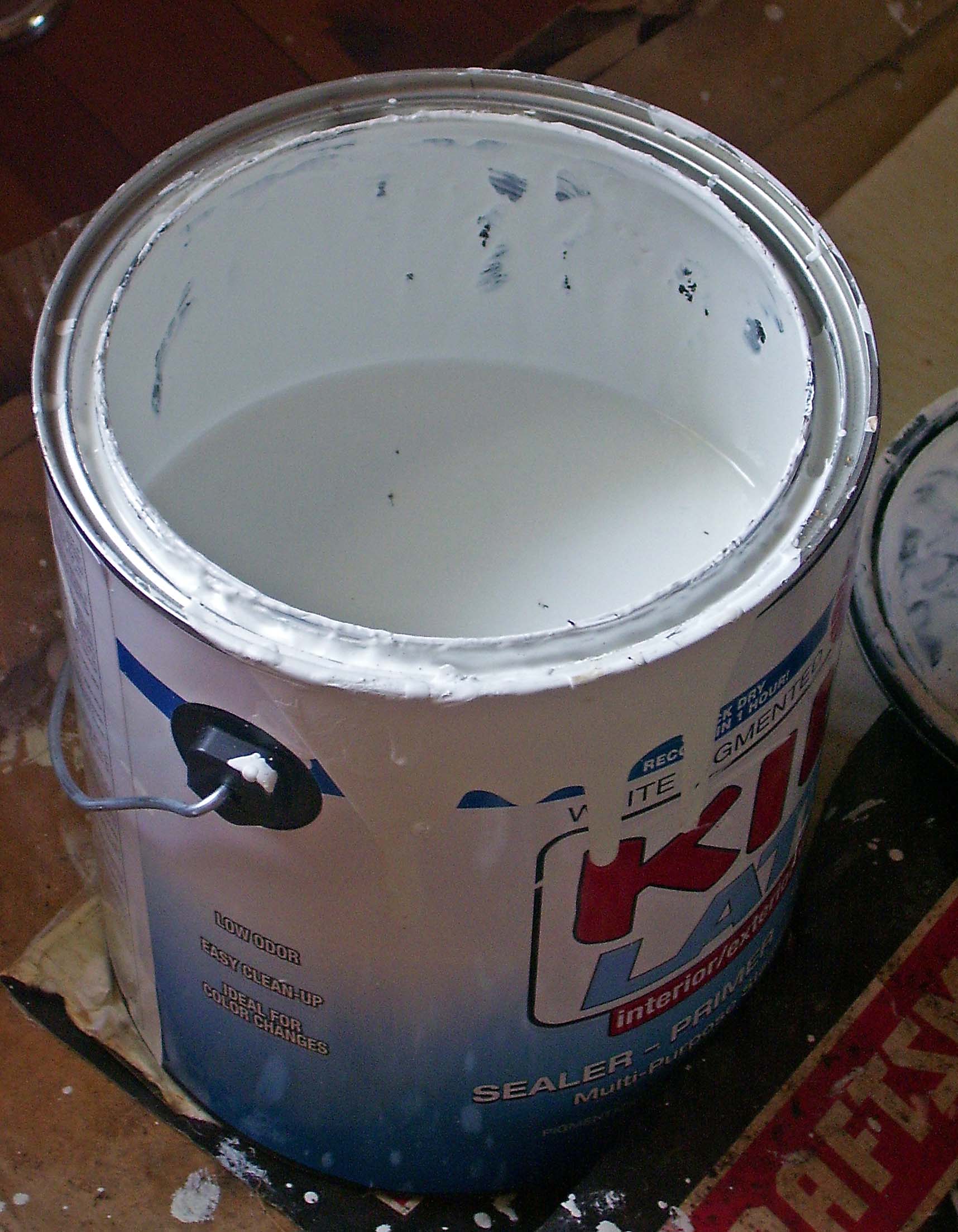
Wood smoke and tobacco smoke also contain hazardous levels of volatile organic compounds, which are partially responsible for the deadly health effects of smoking. Unfortunately, tens of millions of Americans regularly inhale VOC's from cigarettes, second-hand smoke, wood-burning stoves, and hazardous workplaces.
Here are some examples of some common products and processes that expose you to harmful VOCs.
Sources of VOCs In and Around Your Home
- Cleaning solutions & disinfectant sprays
- Air fresheners and other artificial fragrances
- Cooking fumes
- Cigarette smoke
- Wood-burning fireplaces
- Scented hair, body, and cosmetic products
- Burning oil or fuel indoors
- Fireplaces and wood-burning stoves
- Pesticides and moth repellent
- Dry-cleaned clothing
- Furniture
- Many glues and adhesives
- Permanent markers, art paints, and other hobby or crafting supplies
- Varnishes and finishes
- Building materials: e.g. paint, paint remover, caulk and sealants, carpet, and flooring (The amount of VOCs emitted by these products declines over time.)
Sources of VOCs Outdoors
- Automobile emissions
- Diesel emissions
- Power plant emissions
- Fuel extraction and processing
- Manufacturing plant emissions
- Emissions from other chemical and industrial processes

How Dangerous are VOCs?
Fortunately, most of the harmful volatile organic compounds only pose a serious danger in large doses or long-term exposures. If you have healthy lungs and only get exposed to small amounts of VOCs, then you are unlikely to experience any major health effects.
However, people with existing lung diseases are often much more sensitive to the effects VOCs. For these people, even low VOC concentrations in the air can trigger respiratory symptoms like coughing and shortness of breath.
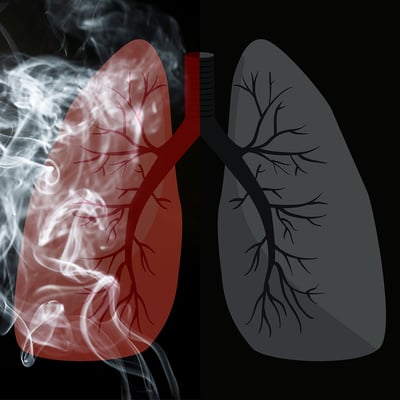
Still, even healthy people can experience short-term and long-term symptoms from low or moderate exposure to certain volatile organic compounds. Many people, for instance, get an itchy nose, watery eyes, or feel lightheaded when they use a noxious chemical like bleach.
Fumes from recently-painted walls can trigger symptoms for days, and new carpeting can emit high levels of VOC's (sometimes referred to as off-gassing) for weeks or months after installation. One study found that even just working in a newly-constructed building can expose you to enough VOC's to cause eye irritation and airway inflammation.
These symptoms are usually fairly mild and disappear on their own once you get away from the source of VOCs. You usually don't need medical treatment unless you've been exposed to unusually high concentrations or an especially toxic VOC.
Here are some of the most common short-term symptoms that VOCs can cause:
- Eye, nose, throat, and lung irritation
- Coughing and sneezing
- Shortness of breath
- Headaches
- Dizziness
- Minor skin irritation
- Worsened asthma and COPD symptoms
- Nausea or vomiting
Whether or not you realized it at the time, chances are almost certain that you've had minor reactions to VOCs before. For example, if you've ever used a cleaning product that made you sneeze, or felt your eyes stinging near a campfire or BBQ, then you've experienced the symptoms of mild VOC exposure.
This level of exposure is generally not dangerous on its own, especially if it only happens every once in awhile. However, if it happens regularly over the span of several years, it could cause long-term damage your lungs or lead to other health complications.
It's important to note that even a one-time exposure to extremely high levels of VOCs can result in much more serious and long-term symptoms. However, severe VOC exposures are relatively rare and happen most often to people in hazardous occupations that require them to work with or around dangerous VOCs.
Should I be Concerned About VOCs?
If you have a lung or breathing disorder like asthma or COPD, then you probably should be concerned about the amounts of VOCs you get exposed to day-to-day. People with lung conditions are much more vulnerable to the damaging effects of volatile organic compounds for a variety of reasons we'll cover in the next section below.
However, if you are a healthy adult, the answer is not so clear-cut. Researchers are still not sure what kind of impact low-level exposure to VOCs can have, in the long term, on your health.
Research suggests that all the VOCs you encounter as you go about daily life could have a cumulative effect, meaning that even mild exposure over a lifetime could lead to chronic disease. For example, several studies suggest that VOCs from regular activities like cooking and cleaning, if you do them frequently enough, could raise your risk for developing COPD later in life.
Because of this, experts generally recommend that you do your best to limit your exposure to VOCs outdoors and in your home. That could include using low-VOC products, keeping your house well-ventilated, and staying away from sources of second-hand smoke.
In general, exposure to VOC's is most likely to be dangerous if:
- You are exposed to moderate or high levels of harmful VOCs
- You are exposed to low levels of harmful VOCs for a long period of time
- You have asthma, COPD, or another respiratory disease
The most clear and severe cases of adverse effects tend to happen in people who are exposed to above average amounts of VOCs. Studies on a wide range of volatile organic compounds have found that overexposure can increase your risk for cancer, blood disorders, lung conditions, and other serious diseases.

Here are some of the long-term health problems that VOCs can cause:
- Lung damage
- Kidney damage
- Liver damage
- Central nervous system damage
- Blood disorders
- Anemia
- Increased risk for cancers like leukemia (from very heavy or long-term exposures)
Volatile organic compounds are an unavoidable part of daily life, but there are still many things you can do to protect yourself from their harmful effects. For instancde, many hazardous VOCs come from man-made sources that you can avoid and keep out of your home.
How VOCs Affect People with COPD and Other Lung Diseases
Volatile organic compounds that affect your respiratory system tend to have particularly bad effects on people with existing lung diseases, especially asthma and COPD. Because of this, many experts advise people with these health conditions to take special measures to avoid VOCs as much as possible.
Asthma and COPD make your lungs extra sensitive to the quality of the air you breathe. Even temporary exposure to small amounts of respiratory irritants, such as dust, fragrances, and VOCs, can trigger coughing fits, shortness of breath, and other respiratory symptoms.
If you have severe COPD, exposure to VOCs can make your breathing symptoms worse for hours or even days. They can also make you more likely to experience a COPD exacerbation.
If you have high levels of VOCs in your home or workplace, it can make it more difficult to manage your disease in general. You might experience more frequent flare-ups, worse shortness of breath, and an increased risk for lung infections.
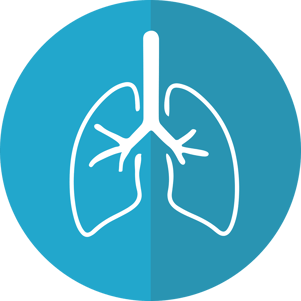
Keeping your symptoms under control is a vital part of keeping your lungs healthy, and anything that triggers them on a regular basis can accelerate irreversible lung damage. Because of this, being exposed to harmful VOCs indoors every day can permanently worsen your COPD.
Over the long term, this could have a significant impact on your overall health and quality of life. It can make it more difficult to breathe, more difficult to sleep, and make activities like walking and doing chores around the house more tiring.
Which VOCs Are Bad for Your Lungs?
Now that we've gone over the basics of volatile organic compounds and their risks, let's take a closer look at some specific VOCs that you may be exposed to every day. In this section, we'll introduce you to several of the most common VOCs that are dangerous to breathe so you can better recognize and avoid them in everyday life.
Formaldehyde

You've probably heard of this volatile organic compound before; formaldehyde is an exceptionally common gas that is dangerous to breathe except in very low concentrations.
This VOC originates from a variety of natural and man-made sources. In fact, your body produces a tiny amount of formaldehyde as part of its normal metabolic functions.
However, many commercial products like wood, soaps, and adhesives contain hazardous amounts of formaldehyde. When you use these products in your home, they can emit enough formaldehyde vapor to make the air unhealthy to breathe.
Even very low levels of formaldehyde can cause mild symptoms like eye, nose, and throat irritation. Sensitivity to formaldehyde varies widely from person to person; some (e.g. people with asthma) experience strong allergic reactions when exposed to even a small amount, while others are only bothered by high concentrations of formaldehyde in the air.
The best way to avoid formaldehyde is to replace formaldehyde-containing products with non-toxic alternatives and avoid bringing formaldehyde-treated furniture and wood into your home. If you must, you should air out your house thoroughly and avoid spending time indoors until the bulk of the formaldehyde has had time to dissipate.
Here are some more details about where formaldehyde comes from, what the symptoms of formaldehyde exposure look like, and how it affects your lungs.

Where Formaldehyde Comes From
- Dish soap
- Cosmetics
- Fabric softeners
- Disinfectants
- Permanent-press fabrics
- Leather treatment products
- Treated woods (e.g. plywood)
- Cigarette smoke
- Burning wood and fuel
- Insulation materials
- Carpets
- Other building materials
- Paints and varnishes
- Glues and adhesives
- Paper
Symptoms of Formaldehyde Exposure
- Nose and throat irritation
- Eye irritation
- Skin irritation
- Runny nose
- Difficulty breathing
- Headache
- Nausea
- Lung function decline
- Nose and throat cancers (rarely from long-term or heavy exposures)
How Formaldehyde Affects Your Lungs
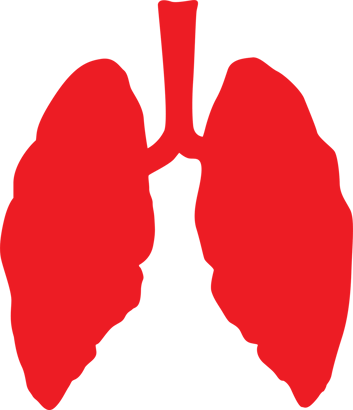
Formaldehyde is toxic to the tissue that lines your respiratory tract in relatively low concentrations. According to the Agency for Toxic Substances and Disease Registry, it is not healthy to breathe air with formaldehyde concentrations above .003 ppm (parts per million).
Some of the most common symptoms of exposure to formaldehyde-contaminated air are eye irritation, nose irritation, and airway inflammation. It can cause serious damage to the delicate tissues in your lungs in high enough concentrations, and long-term exposure can cause chronic respiratory symptoms.
Studies show that workers who are overexposed to formaldehyde on the job experience significant lung function decline. Although it is uncommon, occupational exposure can lead to occupational asthma and rare nose and throat cancers.
Formaldehyde is particularly dangerous for people with existing lung diseases, for whom low levels of formaldehyde can trigger breathing difficulties. One study, for instance, found that formaldehyde released by typical laminate flooring was enough to cause severe respiratory symptoms and possibly even cancers in people with asthma and COPD.
Occupations that Put You at Risk of Formaldehydes Exposure
- Manufacturing plastics, resins, and foam insulation
- Hospital or medical work
- Dentistry
- Laboratory workers
- Construction work
- Textile and furniture workers
- Agricultural work (especially livestock farming)
- Morticians who work with embalming fluids
- Beautician work that exposes you to formaldehyde-containing dyes, cosmetics, and other body products
Benzene
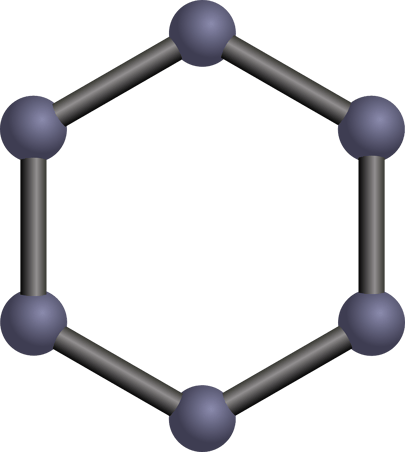
Benzene is an abundant volatile organic compound found in many substances you encounter every day. Most people get exposed to benzene by breathing in gasoline fumes (e.g. while filling up your car) or air contaminated by emissions from cars and other fuel-burning devices.
However, certain common household products like paints, carpet, and glues also contain harmful levels of benzene. These products can heavily pollute the air in your home, especially when used for large projects like installing new carpet or painting your walls.
As the case is with many other VOCs, researchers have difficulty estimating exactly how much benzene is safe to breathe. Recent studies suggest that even low-level benzene exposure (e.g. living next to a gas station) can, over time, raise your risk for leukemia and other serious diseases.
For frequent, long-term exposure, benzene levels as low as 1ppm can be dangerous and result in serious blood disorders. People who work in occupations that expose them to benzene are the most at risk for this and other serious health effects.
Here are some more details about where benzene comes from, what the symptoms of benzene exposure look like, and how this VOC affects your lungs.

Where Benzene Comes From
- Vehicle emissions
- Cigarette smoke
- Paints
- Glues
- Furniture wax
- Carpet
- Wood-burning stoves and fireplaces
- Fuels (e.g. crude oil, coal, and gasoline)
- Forest fires
- Contaminated well water
Symptoms of Benzene Exposure
- Drowsiness
- Dizziness
- Headaches
- Eye irritation
- Skin irritation
- Nose and throat irritation
- Rapid heart rate
- Tremors
- Confusion
- Anemia (long-term exposure)
- Menstrual cycle abnormalities
- Immune system impairment (long-term exposure)
- Death (from extremely high doses)
- Leukemia (from high levels of occupational exposure)
How Benzene Affects Your Lungs
Benzene as a toxin is best known for causing damage to the bone marrow, blood, and DNA. However, a lesser-known problem with benzene is its damaging effects on the lungs.
Benzene is a lung irritant that can inflame your respiratory tract and even destroy cells lining your airways. While mild exposure to benzene is not known to cause long-term respiratory problems, it is still very dangerous to breathe for a variety of other reasons.
People with COPD and other lung diseases, however, may experience a stronger respiratory reaction when exposed to benzene. By inflaming your lungs and airways, it can trigger uncomfortable symptoms like coughing and shortness of breath.
People with COPD should also do their best to stay out of indoor spaces that are contaminated by fumes from new carpet or paint. It's also important not to burn wood in your home or use benzene-emitting products like many paints, varnishes, and furniture.
Occupations that Put You at Risk of Benzene Exposure
- Manufacturing and processing rubber or steel
- Printing or printing ink industry
- Fire fighting
- Working in or around gas stations and fuels
- Fuel extraction and processing
Ethylbenzene
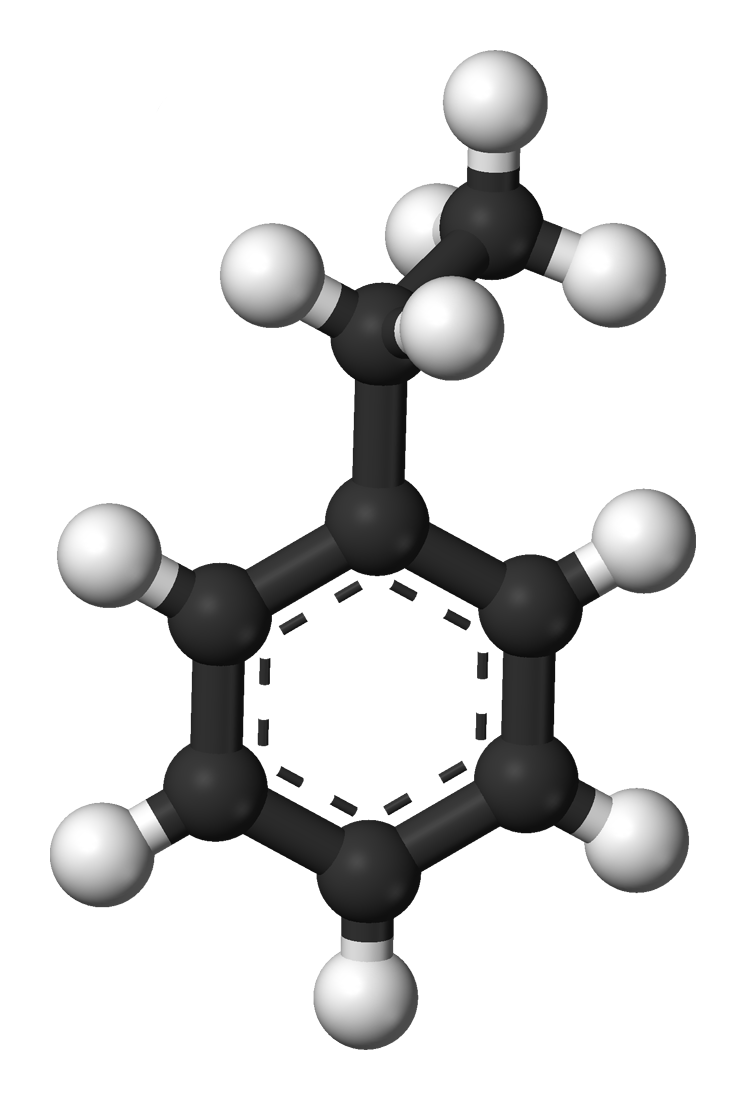
This volatile organic compound is found in many fuels like gasoline and coal. It is also used as a solvent in some common products you might use around your home, including insecticides and glue.
Burning fuel in cars and other machinery is one of the major ways that ethylbenzene gets released into the air. Using products that contain ethylbenzene, such as wall paint or furniture varnishes, can also cause hazardous levels of this noxious VOC to build up inside your home.
You can get exposed to ethylbenzene by breathing it in from the air or by letting it touch your skin. In small doses it may only irritate your respiratory tract, but in large doses it can cause serious nervous system and liver problems.
Ethylbenzene exposure is so common that nearly every person who has been tested has some amount of this VOC in their blood. Researchers have also detected ethylbenzene in many people's exhaled breath and in pregnant women's milk.

Here are some more details about where ethylbenzene comes from, what the symptoms of ethylbenzene exposure look like, and how this VOC affects your lungs.
Where Ethylbenzene Comes From
- Inks
- Paints
- Pesticides
- Fuels (e.g. gasoline, petroleum)
- Coal tar
- Carpet glue
- Tobacco smoke
- Contaminated well water
Symptoms of Ethylbenzene Exposure
- Dizziness
- Vertigo
- Nose, throat and eye irritation
- Chest tightness
- Irritability
- Fatigue
- Functional nervous system impairment
- Hearing loss (long-term exposure)
How Ethylbenzene Affects Your Lungs
If you get exposed to high enough levels of ethylbenzene in the air, it can inflame the sensitive tissues in your nose, airways, and lungs. It can also cause your chest to tighten or feel constricted when you breathe.
In healthy adults, mild exposure to ethylbenzene is not associated with any breathing problems or other respiratory effects. However, airway irritation caused by ethylbenzene exposure might trigger breathing symptoms in people with COPD.
Researchers are not yet sure what levels of ethylbenzene in the air are safe. However, some studies suggest that prolonged exposure to concentrations as low as 100ppm (parts per million) can cause symptoms.
Occupations that Put You at Risk of Ethylbenzene Exposure
- Spray painting
- Varnish work
- Gas and oil work
Ozone

Ozone is actually a gas and not a VOC; however, it is created by VOCs. It's important to bring up ozone because it is a dangerous and potent air pollutant, and because it is direct result of excess VOCs.
When VOCs mix with natural gases—nitrogen oxides, specifically—in the air, the combined chemicals react to create ozone. And while ozone is a healthy part of our earth's upper atmosphere, VOCs emitted by human activities have caused unusually high levels of ozone to accumulate near the ground.

This ground level ozone is a major component of both indoor and outdoor air pollution and it's very unhealthy to breathe. Ozone is a particularly big problem in large, dense cities, especially in geographical areas that tend to trap stagnant air.
Ozone is a particularly hazardous respiratory toxin that can irritate your airways and cause permanent damage to the tissues in your lungs. Unlike many VOCs, ozone can be harmful even when air concentrations are low.
Most people get exposed to ozone primarily through outdoor air pollution. You can also breathe ozone inside your home if outdoor ozone makes it indoors or if the air is contaminated by household VOCs.
The best way to avoid breathing ozone is to avoid outdoor pollution and eliminate sources of ozone and other VOCs in your home. In particular, be wary of certain types of “air purifier” devices that are actually dangerous ozone generators.
When the air quality outside is poor, try to keep the windows and doors in your house closed to prevent ozone and other pollutants from getting in. You should also avoid exerting yourself or doing prolonged activities outside and stay indoors as much as you can.
Here are some more details about where ozone comes from, what the symptoms of ozone exposure look like, and how this VOC-fueled gas effects your lungs.
Where Ozone Comes From
- Outdoor air pollution
- Ozone-generating “air purifying” machines
- Any VOC-emitting source including industrial emissions, vehicle exhaust, chemical solvents, etc.
Symptoms of Ozone Exposure
- Coughing
- Shortness of breath
- Lung inflammation
- Reduced lung function
- Chest pain
- Throat irritation
- Increased risk for respiratory infections
How Ozone Affects Your Lungs

Ozone is a very reactive gas, which makes it toxic to human tissues. The tissues in your lungs and airways are particularly delicate and prone to damage from ozone exposure.
People who are exposed to too much ozone are more likely to develop a variety of chronic health conditions, including asthma, heart disease, and lung function decline. Researchers estimate that ozone pollution causes about 150,000 premature deaths worldwide every year.
Even if you are a healthy adult, small amounts of ozone in the air can cause immediate respiratory symptoms. Repeated and prolonged exposure can cause serious lung damage and lead to chronic diseases like COPD.
People who have existing lung diseases like asthma and COPD are even more vulnerable to the damaging effects of ozone. Exposure can cause severe, or even life-threatening, respiratory symptoms and trigger dangerous COPD exacerbations.
Occupations that Put You at Risk of Ozone Exposure
- Paper and pulp manufacturing
- Waste water treatment
- Any job that requires you to do strenuous outdoor work when outdoor air quality is poor
How to Avoid VOCs that Harm Your Lungs
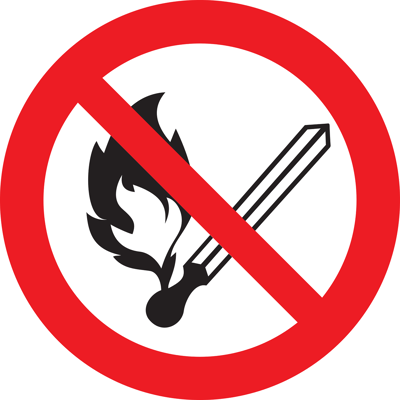
Now that you have a better idea of what VOCs are, where they come from, and why it matters, let's take a look at some practical things you can do about it. In the following sections, we'll show you a variety of tips and techniques for reducing sources of volatile organic compounds in your home and avoiding air contaminated by VOCs.
Know How to Ventilate Your Home Properly
.jpg?width=400&name=open-window(1).jpg)
Good indoor ventilation is one of the most important parts of keeping your indoor air clean and free of harmful VOCs. Airing out your home on a regular basis helps keep the air in your house fresh and prevents pollutants, like VOCs, from building up inside.
It's also important to vent the air from the room whenever you do anything that releases VOCs. This includes activities like cooking, cleaning, and using high-VOC materials like crafting glues and paint.
Unfortunately, many people underestimate the importance of proper ventilation or simply don't want to deal with the hassle of opening windows and setting up fans. However, it's worth taking these few extra steps to protect your lungs from the harmful effects of noxious fumes.
The key to good ventilation (PDF link) is plenty of air flow, whether it comes from a fan, window, door, or an actual exhaust vent. Basically, you need two openings: one for air to move into the room and one for air to go out. You also need a fan to expedite the process and pull the air in the direction you need to move.
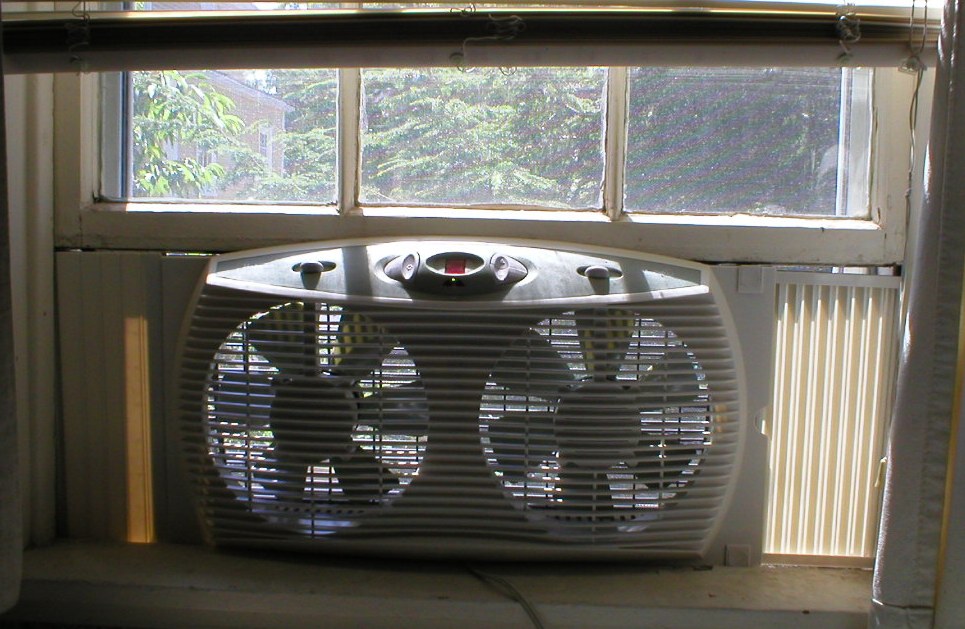
Whenever possible, only use high-VOC products in large, open spaces with more than one window or door. The smaller the space you work in, the more air flow you need to prevent dangerous VOCs from building up to hazardous levels in the room.
Sometimes, opening up windows on opposite sides of your home is enough to establish a strong-enough current to pull the air out of your house. Many kitchens and bathrooms also have ventilation fans designed to suck the air outdoors.
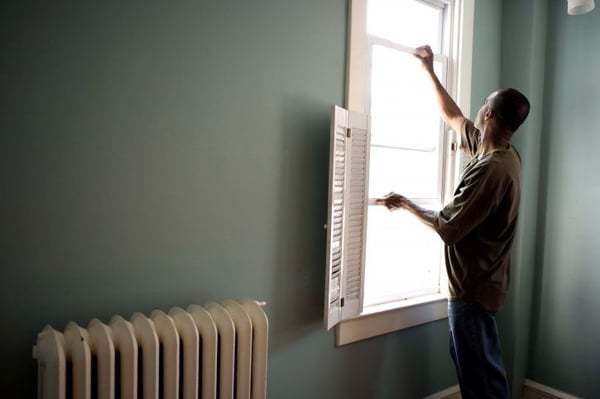
You can also set up fans near windows and doorways to help clear noxious air out of small spaces. Any kind of air flow you can manage to set up will be better than letting VOCs build up in stagnant air.
So when should you take the time to ventilate? The answer is anytime you use a product or do an activity that produces VOCs, especially cooking, painting, and using chemical cleaning sprays.
On the other hand, if you live in a place with poor outdoor air quality, try to be strategic about when you open up your windows and doors. If you air out your house when pollution is high, then you could end up making your indoor air quality even worse.
Use Low-VOC Wood, Paint, and Building Products

Whenever you make a repair or renovation to your home, it's important to be cautious about what materials you use. A wide variety of building and finishing products emit VOCs that are unhealthy to breathe, especially if you have asthma or COPD.
High-VOC building materials include:
- Wood (including lumber, plywood, particle board, etc.)
- Cabinets
- Carpet
- Flooring
- Furniture
- Rugs and other fabrics
- Glues and adhesives
- Varnishes, sealants, and finishers
- Caulk and grout
- Insulation.
- Paints
That's why, whenever you start a new project in your home, you should try to use materials that are low in VOCs. However, this can be difficult or expensive to do, and not all products have low-VOC alternatives.
Here are some resources you can use to find low-VOC building and finishing products:
- Helpful tips for findng low-emission wood, cabinets, paint, flooring, adhesives, insulation, and more
- EPA guidelines for identifying low-emission building materials (PDF link) from EPA's Indoor airPLUS program
- List of companies that offer ultra-low emitting formaldehyde (ULEF) or no added formaldehyde (NAF) wood materials
- Learn how to find Green Label certified, low-VOC carpet, padding, and adhesives
When you must use high-VOC materials, you should take special measures to protect your lungs from the vapors that the products will release into your home. If you have a lung or breathing disorder, that means using a ventilation mask when handling them and thoroughly ventilating any indoor spaces you use them in.

Most furniture and building materials emit the most VOCs when they are new, meaning shortly after they are manufactured or installed. Afterward, as long as the materials sit undisturbed, the amount of VOCs they release will slowly decrease over time.
Wood also tends to emit more VOCs immediately after being handled, for example, when it's cut, sanded, or nailed into place. Because of this, wood materials tend to emit the most VOCs shortly after construction and installation, but those levels drop gradually in the following hours, days and weeks.
Because of this, experts recommend (PDF link) that you allow building materials like carpet and wood to air out before bringing them indoors. That way, they will release the bulk of their VOC's outdoors instead of polluting the air in your home.
This is also true for varnishes, solvents, and paint; they release large amounts of noxious VOCs right after you use them, but produce less and less after they dry. Because of this, you need to ventilate the space both during and after using these products, and continue until the noxious vapors completely subside.
The same goes for new wood, carpet, or other high-VOC materials that you might bring into your home. Make sure there is plenty of air flow through your house while the project is ongoing, and continue to air out the space for as long as you expect the materials to continue emitting high levels of VOCs.

How long you need to ventilate your home will depend on the type of materials you use and the magnitude of their VOC emissions. For example, you might only need to air out the room for an afternoon or so if you only use a small amount of varnish. On the other hand, if you cover all the walls in a room with new paint, it might take a few days before the air is safe to breathe.
Here are some more tips for protecting yourself lungs from building material VOCs:
- Always use proper breathing protection (e.g. chemical respirator) when painting, caulking, or using other high-VOC materials.
- If you have COPD, it might be dangerous to work with high-VOC materials at all. Instead, enlist friends, family, or hire a professional to handle the project.
- Open doors, windows, and set up fans to establish good airflow whenever your or someone else is using varnish, paint or other high-VOC construction materials indoors.
- Avoid going inside your home entirely and stay at a friend or family member's home if you need to get away from fresh paint fumes or high VOC levels caused by other home projects.
- Do not store high-VOC wood and other materials inside your home unless you will be using them right away; instead, place them outside, in your garage, or in an off-site storage space.
Use Low-VOC Cleaning Solutions and Other Home Products

Common household products like bleach, ammonia, herbicides, and pesticides are a major source of VOCs. In fact, they account for a substantial portion of air pollution indoors.
Some research even suggests that using high-VOC products to do regular cleaning around the house has the potential to do irreversible damage to your lungs. Because these products are so widespread, they cause a significant amount of outdoor air pollution, as well.
Here's a list of some high-VOC products that are commonly used indoors:
- Bleach
- Glass cleaners and wipes
- Floor cleaners
- Carpet cleaners and powders
- Toilet cleaning blocks and gels
- Air fresheners (including aerosols, liquids, and oils)
- Furniture polish
- A large percentage of commercial cleaning solutions in general
- Click here to see a more comprehensive list of common formaldehyde-containing home products from the US Department of Health and Human Services
If you have COPD, using high-VOC products in your home is always risky, both in the short and long term. Many produce noxious fumes that can immediately trigger severe COPD symptoms and make it difficult to breathe for awhile
But even after the VOCs dissipate, they linger in the air where they can continue to affect your lungs and make it difficult to manage your symptoms at home. That's why you should not only avoid personally handling these products, but also discourage anyone from using them in your home.

You can do this by replacing high-VOC products with low-VOC alternatives. In many cases, this means avoiding commercial chemicals and cleaning solutions altogether, since the majority of them emit unhealthy levels of hazardous VOCs.
Instead, you can make your own cleaning solutions with simple, non-toxic ingredients. We even have a handy guide you can use with instructions for how to create DIY cleaners to handle a variety of cleaning tasks.
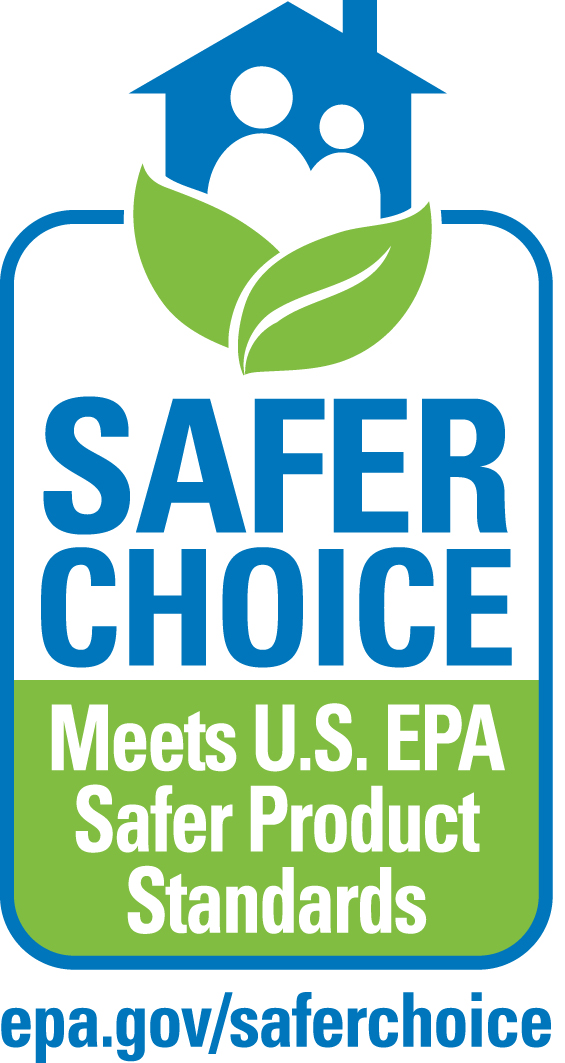
When using a chemical disinfectant is unavoidable, try to enlist the help of friends or family instead of doing it yourself. Even then, it's important to keep the area well-ventilated while cleaning, and to air the house out afterward, too.
You should also be cautious about using pesticides in and around your home. If you must use them indoors, make sure you don't apply them yourself and don't go inside until your house has had time to sufficiently air out.

Often, you can reduce or eliminate the need for pesticides by addressing the root of your pest problem. Many pest issues, for example, can be solved by sealing up entry points in the building's foundation and perimeter, or doing some deep cleaning and re-arranging to get rid of food and environments that attract pests.
Depending on the nature of your pest problem, you may even be able to find low-VOC or non-chemical pest-busting solutions. For example, you can buy special traps to catch and kill many types of insects both inside and outdoors.
Avoid Spray Bottles and Aerosols

Nearly all products that come in spray bottles or cans contain VOCs that are unhealthy to breathe. This includes fragrances, sanitizing sprays, cleaning solutions, hair sprays, and more.
When you use these sprays, they mist the solution, which releases large amounts of VOCs. The tiny droplets evaporate and mix into the air very quickly, making them even more polluting than non-misting solutions.

Some studies show that common household sprays are a major source of indoor air pollution and can lead to a variety of health problems, especially in vulnerable groups (e.g. young children, pregnant women, and people with lung diseases). Spray products are linked to symptoms like diarrhea, headaches, coughing, eczema, nausea, and possibly even more serious conditions like depression.
That's why you should opt for products that come in containers for pouring and avoid anything with a spray nozzle. Then, you can apply the solution with a cloth, sponge, or even your hands in the case of hair and body products.
This method may still expose you to unhealthy VOCs, but it's still a much better option than using an aerosol or spray. When you can't avoid using VOC-containing solutions, you should always try to find a way to use them that doesn't involve spraying them into the air you breathe.
Always Use Chemicals and Commercial Products as Directed
Unfortunately, sometimes using chemical cleaning products and pesticides is unavoidable. Whenever this happens, however, you should be extra cautious to use them as safely as possible.
That means always reading and following the directions that come with the product. All chemicals and cleaning products come with detailed instructions and safety information, and they are certainly not meant to be ignored.
Many chemicals require special handling in order to avoid touching or breathing in toxic chemicals, including VOCs. You may also need to know how to avoid dangerous (or even deadly) chemical interactions that can happen if the product comes into contact with other materials or substances.

If a product says to use it in a well-ventilated space, make sure to get some air flow going before you open it up. If it says to use gloves, wear a respirator mask, or take any other special precautions, make sure you have and actually use all the supplies you need.
And as we've already discussed, ventilating the area both during and after using these products is absolutely key. Remember, most of these products continue to release harmful VOCs for hours after use. In fact, some VOC emissions actually increase for several hours before reaching their peak and finally beginning to subside.
Avoid All Sources of Smoke and Second-Hand Smoke

All types of smoke, whether they come from a cigarette, barbeque, or a fireplace, are also sources of hazardous VOCs. That's why it's important to avoid all sources of smoke, including secondhand smoke, especially if you have COPD.
You should never use a wood-burning stove to heat your house or bring any other source of smoke indoors. You should also avoid environments and workplaces that expose you to excessive amounts of vehicle exhaust or smoke from cooking fumes.
Indoor Air Quality is Important
VOCs are just about everywhere, and they pose enough of a hazard to warrant real concern. Even healthy adults can suffer negative health effects from VOC exposure, and they pose a particular danger to people with asthma, COPD, and other lung diseases.
But even though it's impossible to avoid VOCs completely, there are many practical ways to minimize your exposure. Even simple steps, like using low-VOC product alternatives and using proper ventilation when you cook and clean, can significantly improve your indoor air quality and reduce the amount of VOCs you breathe.
While these solutions can sometimes be a hassle, keep in mind that your efforts help more than just yourself. By reducing your use of VOC-heavy products, you help improve outdoor air quality for everyone who lives and breathes the air in your community.
If you'd like to learn more about how to improve your indoor air quality and remove harmful pollutants like VOCs from your home, check out the following guides:


.png)



